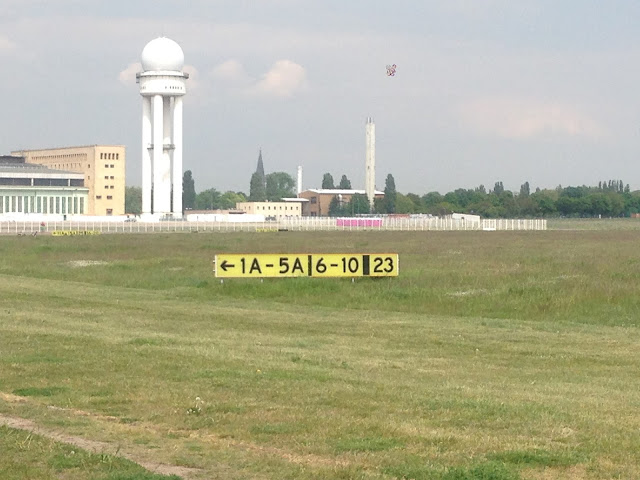 |
| View from the entrance: "Zentrale Flughafen" (central airport) |
In 1905, there was a long-distance flight competition held at Tempelhof with over 20 teams from 8 different countries participating, and that's when talk of a real airport began. By 1920, the plans were made and the Tempelhof Airport opened its doors in 1923.
By 1930, using only grass runways, it was the busiest airport in all of Europe, though that didn't last long... Hitler took a personal interest in the airport and ordered major renovations and expansions. We can still clearly see the Third Reich architecture of the airport to this day, even though the renovations weren't all completed. In the meanwhile, the airport became one of the first concentration camps in Germany, though by 1936, it had shut down and was destroyed two years later. During the war, Tempelhof also served as a weapons-manufacture. Over 2,000 foreigners and immigrants forced into labour worked to make weapons and bomber planes.
The fondest memories of Tempelhof, though, are associated with the Cold War period. When the city was divided, the Soviets created the Berlin Blockade; they blocked every single land route of West Berlin, in hopes of choking that side of the city so it would surrender and they would have the entirety of Berlin rather than just half. Of course, the Allies didn't let that happen. With the help of the US Forces, they created what was called as the Airlift. They sent all the provisions, food, water, gasoline, etc, by plane.
The majority of those planes were landing at Tempelhof. The Blockade lasted 11 months, during which there were airplanes landing every 60-90 seconds. There were so many planes, that sometimes they couldn't even land to drop their goods. This called for another airport... so Tegel airport was built in a record-breaking 90 days and is still functional to this day. Over the course of 11 months, there were over 278,000 missions, and over 2.3 million tonnes of provisions given to the 2.1 million West Berliners, which definitely kept them alive long enough for the Soviets to give up the Blockade (and decide to build a wall instead... but that's a whole different story).
After that, Tempelhof returned to its original purpose: a civilian airport and served from the 60's until 2008, when it closed its doors. Many West Berliners fought very hard to keep Tempelhof and was given a protected status, so nothing can be built on the grounds. It is also home to over 150 different insect and bird species, some of which are endangered.
Tempelhof became a public building and space: the airport is home to a military base, a police force, a kindergarten, a nightclub, as well as hosts all sorts of events. There are 7 hangars, the smallest can accommodate 2,000 people, so you can see how using the space for charity balls or conventions would keep the place alive. Right now, it is being repurposed once again to help accommodate Syrian refugees.
As for the 300+ hectares of green spaces and paved runways? Well if you want to have a BBQ, fly a kite or go for a jog, it's the perfect place. It's truly an amazing place; the original signs on the runways are still there, there's even an old airplane or two on display in the field and the airport still looks exactly like an airport, all the gate signs and even the check-in desk are still there.
If you're interested in the historical part of things, there are signs scattered about with information about Tempelhof's history and tours offered inside the building. Lots for everyone!
Tempelhof symbolizes freedom for many. It helped save the lives of the West Berliners and they have responded in kind by saving its life.















No comments :
Post a Comment